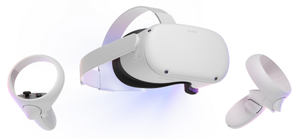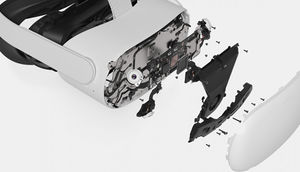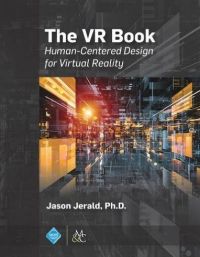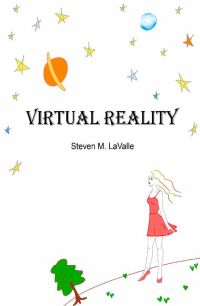Difference between revisions of "CSE191S2022"
(→Format) |
(→Grading) |
||
| (22 intermediate revisions by one user not shown) | |||
| Line 25: | Line 25: | ||
==Course Schedule== | ==Course Schedule== | ||
| − | [[ | + | [[CSE191S2022Schedule | Click here for the course schedule]]. |
It lists lecture dates, homework due dates and recommended reading. | It lists lecture dates, homework due dates and recommended reading. | ||
| Line 31: | Line 31: | ||
==Topics== | ==Topics== | ||
| − | In this course the following topics | + | In this course the following topics may be covered. We will discuss the final list of topics in class. |
# Overview of the state-of-the-art VR technologies and research trends | # Overview of the state-of-the-art VR technologies and research trends | ||
| − | # VR | + | # VR software development with Unity |
| − | + | ||
# Fundamental physics of 3D displays | # Fundamental physics of 3D displays | ||
| − | # | + | # 3D display types: LCD, OLED, volumetric, light field |
| − | + | ||
# Immersive VR systems: Head Mounted Displays, CAVE, smart phone VR, etc. | # Immersive VR systems: Head Mounted Displays, CAVE, smart phone VR, etc. | ||
| − | # | + | # 3D tracking systems and controllers |
# Rendering to Head Mounted Displays | # Rendering to Head Mounted Displays | ||
| + | # Counteracting motion sickness | ||
| + | # Spatial audio for VR | ||
| + | # Augmented reality devices | ||
| + | # Capturing and displaying panoramic 3D images and video | ||
==Prerequisites== | ==Prerequisites== | ||
| − | * CSE167 (Introduction to Computer Graphics) or equivalent | + | * No formal prerequisites |
| + | * CSE167 (Introduction to Computer Graphics) or equivalent recommended but not required | ||
==Format== | ==Format== | ||
| Line 52: | Line 55: | ||
* Number of Units: 2 | * Number of Units: 2 | ||
* Section ID: 84652 | * Section ID: 84652 | ||
| − | * Lectures: Tuesdays 11am-12:20pm in the VR lab, room B210 (EBU-3B) | + | * Lectures: Tuesdays 11am-12:20pm in the VR lab, room B210 (EBU-3B) in-person |
| − | * Office Hour: Mondays 7pm on Zoom | + | * Office Hour: Mondays 7pm on Zoom at https://ucsd.zoom.us/j/93052169849 |
| − | + | * Discussion board on Piazza (access through Canvas) | |
| − | + | ||
* Grade management: Canvas | * Grade management: Canvas | ||
| Line 62: | Line 64: | ||
{| border="1" style="text-align:left;" | {| border="1" style="text-align:left;" | ||
|- | |- | ||
| − | | Project | + | | [http://ivl.calit2.net/wiki/index.php/ProjectS22 Programming Project] |
| 30% | | 30% | ||
|- | |- | ||
| − | | | + | | Weekly Reading |
| 30% | | 30% | ||
|- | |- | ||
| − | | | + | | [[CSE191S22TechPresentation | Technology Presentation]] |
| − | | | + | | 20% |
|- | |- | ||
| − | | [[ | + | | [[CSE191S22AppPresentation | App Presentation]] |
| − | | | + | | 20% |
|} | |} | ||
| − | + | Your grades will show up on Canvas. Please let your instructor know if you find an error. | |
The final grade depends on the weighted average of all your scores. The following grading key will be used: | The final grade depends on the weighted average of all your scores. The following grading key will be used: | ||
| Line 107: | Line 109: | ||
For graduate students with the S/U option: A satisfactory (S) grade will be given for an average grade of 75 or higher. | For graduate students with the S/U option: A satisfactory (S) grade will be given for an average grade of 75 or higher. | ||
| − | == | + | ==Programming Assignment== |
| − | + | You can find the VR project [http://ivl.calit2.net/wiki/index.php/ProjectS22 here]. | |
| − | + | The assignment will be due at the end (Friday) of finals week. | |
| − | + | ||
| − | + | ||
| − | + | ||
| − | + | The project is a solo project. You are allowed to discuss concepts and approaches with your fellow students, but each student needs to submit their own project and needs to have implemented all parts of it themselves. | |
To submit your project, make a video of your app showcasing all its features and upload it to Canvas by the due date. | To submit your project, make a video of your app showcasing all its features and upload it to Canvas by the due date. | ||
| − | |||
| − | |||
==Internet Resources== | ==Internet Resources== | ||
UCSD's VR Club TritonXR has some excellent resources to help you get started creating VR applications with Unity. | UCSD's VR Club TritonXR has some excellent resources to help you get started creating VR applications with Unity. | ||
| − | * [https:// | + | * [https://drive.google.com/drive/folders/0B0TPLmj3665IYXI5ZjFEOXg1Q3M?resourcekey=0-xLgSYnYz7Eq6E54MGxJfFg&usp=sharing Workshop Slides]: Take a look at the "Technical" folder for Unity-specific workshops. If you're interested, there are also non-technical design slides that are interesting for VR. |
* [https://bit.ly/ucsdvrunityguide Unity Tutorial Guide] This guide helps you navigate Unity's many offered tutorials. | * [https://bit.ly/ucsdvrunityguide Unity Tutorial Guide] This guide helps you navigate Unity's many offered tutorials. | ||
Latest revision as of 00:16, 19 April 2022
Contents |
CSE 191: Virtual Reality Technology
Course Description
Virtual reality (VR) has been capturing people's imagination for decades, but it has been only recently that this technology became available for consumers. This seminar course aims to explain how VR technology works, and you are going to do programming projects to better understand potential and limitations of today's VR hardware and devices.

|

|
| Oculus Quest 2 | Oculus Quest 2 Interior |
Computer Hardware Requirements
In order to be able to do the homework projects in this course you will need to have:
- A Windows or Apple computer (desktop or laptop) with the ability to run Unity. You can use the Windows PCs in the VR lab.
- A VR headset with two controllers. You can borrow an Oculus Quest 2 from the VR lab for the duration of the quarter.
Course Schedule
Click here for the course schedule.
It lists lecture dates, homework due dates and recommended reading.
Topics
In this course the following topics may be covered. We will discuss the final list of topics in class.
- Overview of the state-of-the-art VR technologies and research trends
- VR software development with Unity
- Fundamental physics of 3D displays
- 3D display types: LCD, OLED, volumetric, light field
- Immersive VR systems: Head Mounted Displays, CAVE, smart phone VR, etc.
- 3D tracking systems and controllers
- Rendering to Head Mounted Displays
- Counteracting motion sickness
- Spatial audio for VR
- Augmented reality devices
- Capturing and displaying panoramic 3D images and video
Prerequisites
- No formal prerequisites
- CSE167 (Introduction to Computer Graphics) or equivalent recommended but not required
Format
- Instructor: Dr. Jürgen Schulze
- Number of Units: 2
- Section ID: 84652
- Lectures: Tuesdays 11am-12:20pm in the VR lab, room B210 (EBU-3B) in-person
- Office Hour: Mondays 7pm on Zoom at https://ucsd.zoom.us/j/93052169849
- Discussion board on Piazza (access through Canvas)
- Grade management: Canvas
Grading
| Programming Project | 30% |
| Weekly Reading | 30% |
| Technology Presentation | 20% |
| App Presentation | 20% |
Your grades will show up on Canvas. Please let your instructor know if you find an error.
The final grade depends on the weighted average of all your scores. The following grading key will be used:
| Final Score | Letter Grade |
|---|---|
| 100+ | A+ |
| 95+ | A |
| 90+ | A- |
| 85+ | B+ |
| 80+ | B |
| 75+ | B- |
| 70+ | C+ |
| 65+ | C |
| 60+ | C- |
For undergraduate students with the P/NP option: A pass (P) grade will be given for an average grade of 60 or higher.
For graduate students with the S/U option: A satisfactory (S) grade will be given for an average grade of 75 or higher.
Programming Assignment
You can find the VR project here.
The assignment will be due at the end (Friday) of finals week.
The project is a solo project. You are allowed to discuss concepts and approaches with your fellow students, but each student needs to submit their own project and needs to have implemented all parts of it themselves.
To submit your project, make a video of your app showcasing all its features and upload it to Canvas by the due date.
Internet Resources
UCSD's VR Club TritonXR has some excellent resources to help you get started creating VR applications with Unity.
- Workshop Slides: Take a look at the "Technical" folder for Unity-specific workshops. If you're interested, there are also non-technical design slides that are interesting for VR.
- Unity Tutorial Guide This guide helps you navigate Unity's many offered tutorials.
EdX course 190x teaches VR with Unity on smartphones with lots of videos and hands-on tutorials. You can audit it free of charge.
Or you can view just the tutorial videos which walk you through the steps to create a VR app for your smartphone.
Run your Quest 2 without a Facebook account (requires an old Oculus account).
Useful information on quaternions
Textbooks
You will not need to buy a textbook for this course because the lecture slides will be made available to you, and the material from the lectures will be sufficient for the final exam. However, if you want more in-depth information, we recommend the following books:

|
The VR Book by Jason Jerald, 550 pages, Morgan & Claypool Publishers, October 16, 2015, ISBN-10: 1970001127, ISBN-13: 978-1970001129 |

|
Virtual Reality by Steven M. LaValle. To be published by Cambridge University Press. Download PDF |
Students with Disabilities
If you have a documented disability, please email me your documentation to me as soon as possible so that I can make suitable accommodations for you. If you believe that you have a disability and desire accommodation, please register with the Office for Students with Disabilities.